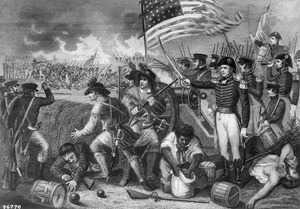Battle of New Orleans
| Battle of New Orleans | |||||||
|---|---|---|---|---|---|---|---|
| Part of the War of 1812 | |||||||
 The Battle of New Orleans by Henry Bryan Hall after William Momberger |
|||||||
|
|||||||
| Belligerents | |||||||
|
|
|
||||||
| Commanders and leaders | |||||||
|
|
|
||||||
| Units involved | |||||||
|
Land: U.S. Army U.S. Marines U.S. Navy sailors Choctaw warriors Baratarian pirates Civilian volunteers State Militia Privateers 16 guns Sea: 1 schooner 1 sloop-of-war 1 steamboat |
Land: British Army Royal Marines Royal Navy sailors Sea: Sixty Royal Navy ships |
||||||
| Strength | |||||||
| 4,732 | 14,450 | ||||||
| Casualties and losses | |||||||
| 13 killed 30 wounded 19 missing Total: 62 |
285 killed 1,265 wounded 484 captured Total: 2,034 |
||||||
Decisive American victory
The Battle of New Orleans was an engagement fought between January 8 and January 18, 1815, constituting the final major battle of the War of 1812, and the most one-sided battle of that war. American combatants, commanded by Major General Andrew Jackson, prevented an overwhelming British force, commanded by Admiral Alexander Cochrane and General Edward Pakenham, from seizing New Orleans and the vast territory the United States had acquired with the Louisiana Purchase.
The Treaty of Ghent had been signed on December 24, 1814 (but was not ratified by the US Government until February 1815), and hostilities continued without the involved parties knowing about the Treaty, until January 18 by when all of the British forces had retreated, finally putting an end to the Battle of New Orleans.
By December 12, 1814, sixty British ships with 14,450 soldiers and sailors aboard, under the command of Admiral Sir Alexander Cochrane, had anchored in the Gulf of Mexico to the east of Lake Pontchartrain and Lake Borgne. Preventing access to the lakes was an American flotilla, commanded by Lieutenant Thomas ap Catesby Jones, consisting of five gunboats. On December 14, around 1,200 British sailors and Royal Marines under Captain Nicholas Lockyer set out to attack Jones' force. Lockyer's men sailed in 42 longboats, each armed with a small carronade. Lockyer captured Jones' vessels in a brief engagement known as the Battle of Lake Borgne. 17 British sailors were killed and 77 wounded, while 6 Americans were killed, 35 wounded, and 86 captured. The wounded included both Jones and Lockyer. Now free to navigate Lake Borgne, thousands of British soldiers, under the command of General John Keane, were rowed to Pea Island, about 30 miles (48 km) east of New Orleans, where they established a garrison.
...
Wikipedia
